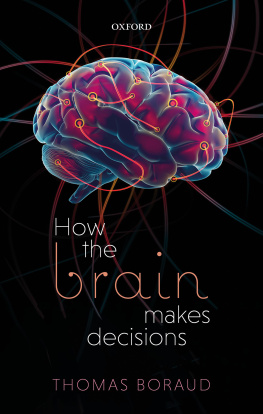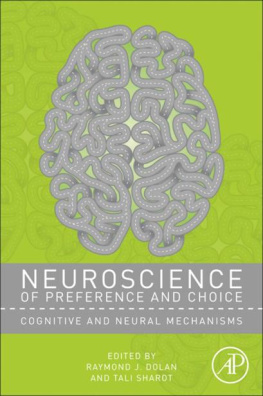NEUROSCIENCE OF DECISION MAKING
The intersection between the fields of behavioral decision research and neuroscience has proved to be fertile ground for interdisciplinary research. Whereas the former is rich in formalized models of choice, the latter is rife with techniques for testing behavioral models at the brain level. As a result, there has been the rapid emergence of progressively more sophisticated biological models of choice, geared toward the development of ever more complete mechanistic models of behavior.
This volume provides a coherent framework for distilling some of the key themes that have emerged as a function of this research program, and highlights what we have learned about judgment and decision making as a result. Although topics that are theoretically relevant to judgment and decision-making researchers are addressed, the book also ventures somewhat beyond the traditional boundaries of this area to tackle themes that will be of interest to a greater community of scholars.
Neuroscience of Decision Making provides contemporary and essential reading for researchers and students of cognitive psychology, neuroscience, philosophy, and economics.
Oshin Vartanian obtained his PhD in experimental psychology at the University of Maine, followed by postdoctoral fellowships in cognitive neuroscience at York University and DRDC Toronto, where he is currently a Defence Scientist. He is the recipient of the Daniel E. Berlyne Award from the American Psychological Associations Division 10 for outstanding research by a junior researcher, and holds an Adjunct Assistant Professorposition in the Department of Psychology at the University of TorontoScarborough.
David R. Mandel is an adjunct professor of psychology at the University of Toronto and a senior defence scientist at DRDC Toronto, where he heads the Thinking, Risk, and Intelligence Group. His areas of research interest include thinking and reasoning, judgment and decision making, and the application of behavioral science to issues in the realm of defence and security. He is the lead editor of The Psychology of Counterfactual Thinking , published by Routledge/Taylor & Francis.
CONTEMPORARY TOPICS IN COGNITIVE NEUROSCIENCE SERIES
Series Editors:
Stanislas Dehaene , Collge de France, Paris
Alvaro Pascual-Leone , Harvard Medical School, USA
Jamie Ward , University of Sussex, UK
Reflecting contemporary and controversial issues in the study of cognitive neuroscience, the series aims to present a multi-disciplinary forum for cutting edge debate that will help shape this burgeoning discipline. It offers leading figures in the field and the best new researchers the opportunity to showcase their own work and theories, placing them in the wider context of the field.
Titles in the series may be authored or edited; each book must aim to make a contribution to a specific topic by reviewing and synthesizing the existing research literature, by advancing theory in the area, or by some combination of these missions.
Published titles in the series
Neuroscience of Decision Making
Edited by Oshin Vartanian & David R. Mandel
Forthcoming
Neural Bases of Human Belief Systems
Edited by Frank Kruger & Jordan Grafman
Language and Action in Cognitive Neuroscience
Edited by Yann Coello and Angela Bartolo
For more information about the series, please visit www.psypress.com/ctcn
List of figures and tables
| Figure 1.1 |
| Figure 1.2 |
| Figure 1.3 |
| Figure 1.4 |
| Figure 1.5 |
| Figure 1.6 |
| Figure 1.7 |
| Figure 2.1 |
| Figure 2.2 |
| Figure 2.3 |
| Figure 2.4 |
| Figure 2.5 |
| Figure 3.1 |
| Figure 3.2 |
| Figure 3.3 |
| Figure 3.4 |
| Figure 3.5 |
| Figure 4.1 |
| Figure 4.2 |
| Figure 4.3 |
| Figure 4.4 |
| Figure 4.5 |
| Figure 4.6 |
| Figure 5.1 |
| Figure 5.2 |
| Figure 6.1 |
| Figure 6.2 |
| Figure 6.3 |
| Figure 6.4 |
| Figure 7.1 |
| Figure 7.2 |
| Figure 7.3 |
| Figure 7.4 |
| Figure 7.5 |
| Figure 11.1 |
| Figure 11.2 |
| Figure 12.1 |
| Figure 12.2 |
| Figure 12.3 |
| Figure 12.4 |
| Figure 12.5 |
| Figure 12.6 |
| Figure 13.1 |
| Tables |
| Table 5.1 |
| Table 5.2 |
| Table 5.3 |
Introduction
Oshin Vartanian and David R. Mandel
BACKGROUND AND RATIONALE
The intersection between the fields of behavioral decision research and neuroscience would appear to be fertile ground for interdisciplinary research. Whereas the former is rich in formalized models of choice, the latter is rife with techniques for testing behavioral models at the brain level. Nevertheless, it is only recently that an integrative approach has been embraced leading to the emergence of a full-fledged neuroscience of decision making. For example, in their introduction to Neurobiology of Decision-making , Damasio and colleagues argued that neuroscience had overlooked decision making as much as it had overlooked emotion (Damasio, Damasio, & Christen, 1996). Although this was an accurate description of the state of affairs in the mid-1990s, it is no longer true today. The intervening years have witnessed a steady narrowing of the gap between the two fields as neuroscientific approaches have been employed ever more frequently to tackle key theoretical and applied issues in judgment and decision making. There is a growing sense that biological data can inform judgment and decision-making research by shedding light on its component cognitive and emotional processes (Sanfey, 2007). Our aim with this book has been to provide a coherent framework for distilling some of the key themes that have emerged as a function of this research program, and to highlight what we have learned about judgment and decision making as a result of this process.
Our selection of topics for this book has been determined by three factors. First, we have opted to focus on topics that are theoretically relevant to judgment and decision-making researchers, and about which a critical mass of knowledge in the neurosciences has emerged. These topics include reward and loss, risk and uncertainty, and cooperation and trust, representing the core sections in the current volume. Given the complexity of the problems in these topical areas, it is our belief that a triangulation of approaches is necessary for testing key hypotheses involving brain behavior correspondences. This is reflected in the diversity of approaches used by our contributors to address these problems, including behavioral experiments, brain imaging, neuropsychology, electrophysiology, computational modeling, and investigations of neurotransmitter systems. Where appropriate, our contributors have also borrowed insights from the animal literature to shed light on human behavior. This multifaceted approach by which decision neuroscientists have studied these topics has already borne fruit by contributing to the development of increasingly sophisticated models for processes that are of interest to behavioral decision theorists. Perhaps chief among those processes are the neural systems underlying the computation of subjective value (ODoherty & Bossaerts, 2008) and probability (Knutson, Taylor, Kaufman, Peterson, & Glover, 2005), topics of continued and intense study in this area.









